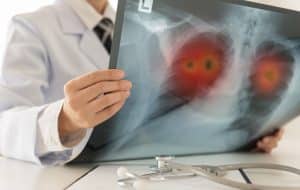Working with a Client with Lung Cancer


Nearly half of all lung cancer clients will be diagnosed with metastatic disease. Lung cancer cells that break off from the original tumor often form a secondary tumor in the brain. An isolated secondary tumor is potentially curable if treated properly with chemotherapy and surgery. Only 15% of lung cancers are diagnosed at a localized stage, for which the five-year survival rate is 54%. The five-year survival rate for small cell lung cancer is 6% compared to 18% for non-small cell.
The following is a list of potential surgical procedures for the treatment of lung cancer:
- Mediastinoscopy – is a relatively non-invasive procedure done under general anesthesia; a small incision is made at the top of the breastbone, and a mediastinoscope is inserted into the chest to take biopsies from the enlarged nodes on the right side of the chest.
- Thoracoscopy – is a surgical procedure to look at the organs inside the chest to check for cancer. An incision is made between two ribs, and a thoracoscope is inserted into the chest. Tissue or lymph node samples may be removed and checked under a microscope for signs of cancer. In some cases, this procedure is used to remove part of the esophagus or lung. If certain tissues, organs, or lymph nodes can’t be reached, a thoracotomy may be done. In this procedure, a larger incision is made between the ribs, and the chest is opened.
- Thoracotomy – is the first step in many thoracic surgeries; and as such requires general anesthesia with endotracheal tube insertion and mechanical ventilation. Thoracotomies are thought to be one of the most difficult surgical incisions to deal with post-operatively, because they are extremely painful and the pain can prevent the patient from breathing effectively, leading to atelectasis or pneumonia.
- Thoracentesis– removal of fluid from the space between the lining of the chest and the lung using a needle. A pathologist views the fluid under a microscope to look for cancer cells.
- Video-assisted thoracoscopic surgery (VATS) – a procedure that may be done before or instead of a thoracotomy. The procedure involves inserting a videoscope with a camera attached (as well as small surgical instruments) into the chest, through small incisions made between the ribs. One of the incisions is enlarged if a lobectomy or pneumonectomy is done to allow the specimen to be removed. Because only small incisions are needed, there is usually less pain after the surgery and a shorter hospital stay – typically 4 to 5 days. The VATS method may be used to confirm the diagnosis of lung cancer, biopsy lymph nodes, perform a wedge resection to remove the cancer and the lung tissue surrounding the cancer, and to remove the segment (lobe) of the lung that contains the cancer.
- Lymph node biopsy – the removal of all or part of a lymph node to look for signs of cancer.
- Segmentectomy – this surgery is designed to remove cancerous tissue from a lung segment when a lobectomy cannot be performed. The lungs have various numbers of segments: three in the right upper lobe, two in the right middle lobe, five in the right lower lobe, four in the left lower lobe and four in the left upper lobe.
- Lobectomy – the standard minimal surgery for lung tumors, in which a section (lobe) is taken out. A bilobectomy removes two lobes in the same lung.
- Pneumonectomy – surgical removal of the entire lung on either the left or right side. It is performed when the cancer is located in the center of the lung and cannot be removed using a more localized operation. A pneumonectomy is only performed in clients who have good lung function and could recover and live without the need for supplemental oxygen.
- Sleeve resection – may be used to treat some cancers in large airways in the lungs. According to the American Cancer Society, if you think of the large airway with a tumor as similar to the sleeve of a shirt with a stain a couple of inches above the wrist, the sleeve resection would be like cutting across the sleeve above and below the stain and then sewing the cuff back onto the shortened sleeve. A surgeon may be able to do this operation instead of a pneumonectomy to preserve more lung function.
- Endobronchial Stenting – inserts a plastic tube into the airway as a palliative treatment for breathlessness.

Many lung cancer patients experience shortness of breath and have difficulty breathing. Restoring breathing will help with endurance and quality of life and will enable lung cancer patients to accomplish their activities of daily living with greater ease.


Potential side effects of lung cancer surgery:
- Infection/bleeding associated with incision
- Pneumonia
- Blood clots in legs or lungs
- Allergic reaction to anesthesia
- Lung collapse caused by tension pneumothorax (air between the lungs and chest wall)
- Hemorrhage
- Air/fluid leaking into the surgical area (bronchopleural fistula)
- Accumulation of fluid in the chest
- Chronic pain
- Abnormal heart rhythms
- Difficulty breathing and need for prolonged stay on the breathing machine
 This exercise is a great place for you to start if you have not been exercising since your surgery. It is a very gentle stretch that can be done by virtually anyone. Begin by sitting on a chair, an exercise ball, or on the BOSU(R) Balance Trainer (for added core strength and balance). With your arms by your sides, sit up tall, “draw” your belly button towards your spine, inhale, and as you exhale, squeeze your shoulder blades together. You should only go to the point of mild discomfort – NO PAIN. Try and hold the stretch for 20-30 second; making sure that you are not holding your breath!
This exercise is a great place for you to start if you have not been exercising since your surgery. It is a very gentle stretch that can be done by virtually anyone. Begin by sitting on a chair, an exercise ball, or on the BOSU(R) Balance Trainer (for added core strength and balance). With your arms by your sides, sit up tall, “draw” your belly button towards your spine, inhale, and as you exhale, squeeze your shoulder blades together. You should only go to the point of mild discomfort – NO PAIN. Try and hold the stretch for 20-30 second; making sure that you are not holding your breath!
To Find a Cancer Exercise Specialist Near You:
